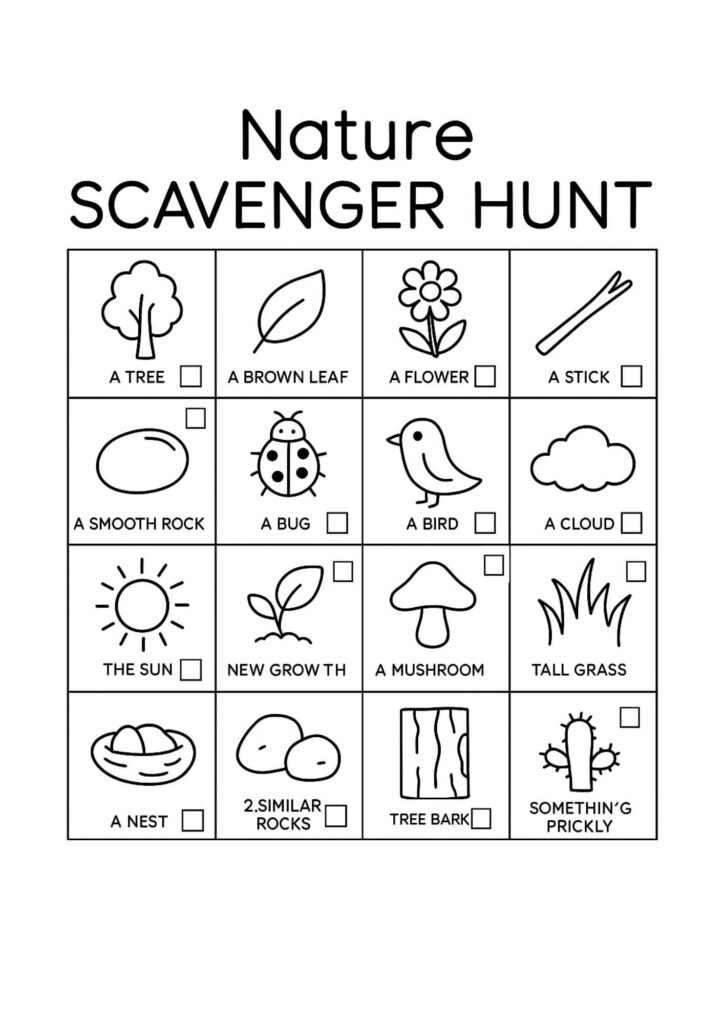Nature is the world’s greatest classroom. With your Free Nature Scavenger Hunt Printable for Kids, you can transform gardens, parks, or schoolyards into investigation zones full of wonder. This simple but powerful activity blends curiosity, movement, and observation — helping children engage deeply with their environment while meeting educational goals.
Why a Nature Scavenger Hunt Works So Well
- It invites wonder and noticing. When children search for items like leaves, insects, textures, or signs of wildlife, they slow down, observe closely, and develop awareness of the little things around them.
- It connects movement with learning. Outdoor searches combine physical activity and cognitive engagement — a powerful mix for energy regulation and focus.
- It supports inquiry-based learning. The scavenger hunt is open-ended: “What’s this? Why might it be here? What changes over seasons?”
- It fits all ages and pacing. Younger children can find simple items; older ones can lead mini investigations (e.g. leaf shapes, diversity).
- It nurtures belonging and stewardship. As children explore their outdoor spaces, they grow a sense of connection to place, awareness of nature, and motivation to care for their surroundings.
How to Use the Scavenger Hunt Printable Outdoors
1. Choose a Location
Select a safe outdoor area with variety — shrubs, grasses, trees, rocks, paved paths, bark, flowers, insects, etc.
2. Introduce the Hunt
Show the printable to children and explain: you’ll walk, observe, and tick off items from the list. Encourage curiosity — children can write or draw notes beside each found item.
3. Walk & Discover
Let children move freely in pairs or small groups. Encourage them to talk about what they see: textures, colours, shapes, smells, movement.
4. Collect or Observe
Depending on your setting, children can bring small safe items (leaves, petals) or take photos/sketches of things they cannot pick up (mushrooms, lichens, insects).
5. Reflect & Share
Back together, ask: What surprised you? What item was hardest to find? Invite children to draw their favourite find or tell a short “nature story.”
6. Extend
- Turn found items into art or collage
- Map the pattern of items across zones
- Re-run the hunt in different seasons and compare
- Use magnifiers to zoom in on textures, pores, or leaf veins
Learning & Wellbeing Connections (MTOP Outcomes)
- Outcome 3 (Wellbeing): Time outside reduces stress, builds calm focus, and supports children’s connection to nature.
- Outcome 4 (Learning): Observing, classifying, hypothesising and comparing deepen scientific thinking.
- Outcome 5 (Communication): Sharing findings, describing observations, and discussing changes build vocabulary and discourse.
- Outcome 2 (Community/Belonging): Working together and caring for outdoor spaces fosters respect and stewardship of shared places.
- Outcome 1 (Identity): Children see themselves as explorers and nature-aware individuals, strengthening connection to their environment.
Tips & Adaptations
- Younger kids: Use fewer, more obvious items (leaf, rock, petal, stick).
- Older kids: Include categories such as insect, fungi, microbe clue, lichen, wind effect, or colour spectrum.
- All-inclusion: Use clipboards, tactile cards, magnifying glasses, or audio descriptions for differently-abled learners.
- Seasonal hunts: Tailor the list for autumn leaves, spring blossoms, summer insects, or winter seeds.
- Cross-curricular: Link to art (nature sketching), maths (counting items), literacy (nature journaling).
Download
👉 Download the Free Nature Scavenger Hunt Printable for Kids
Print it, take it outside, and let your children awaken to the hidden world around them — one discovery at a time.

